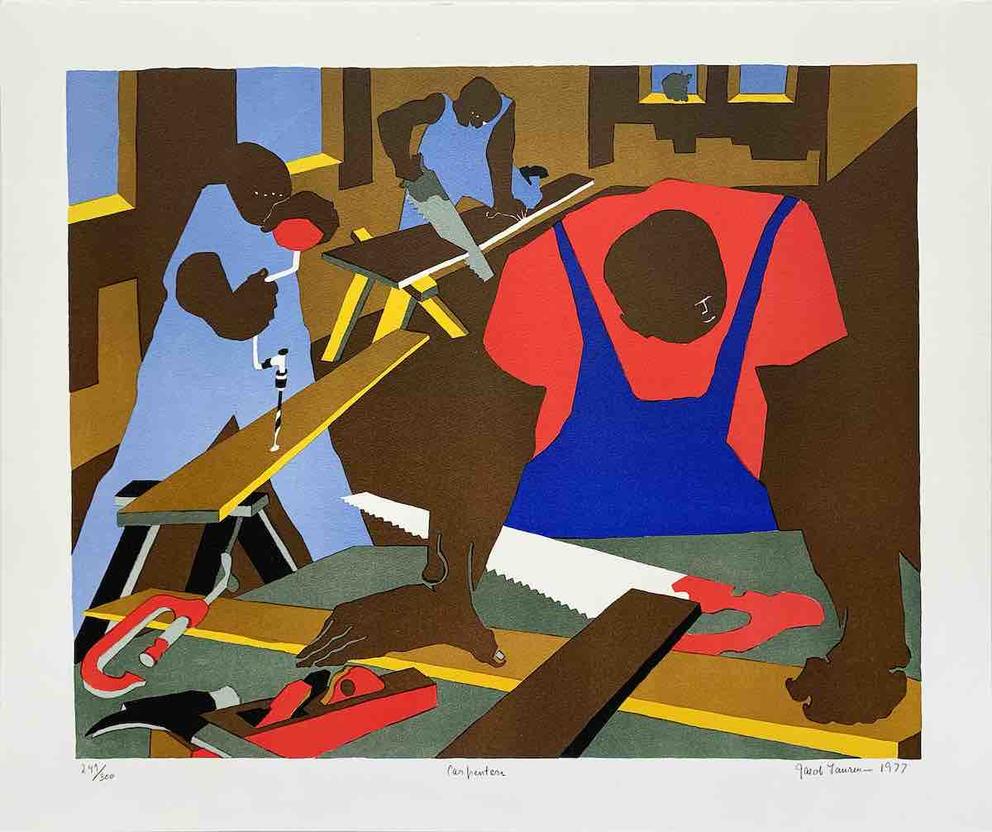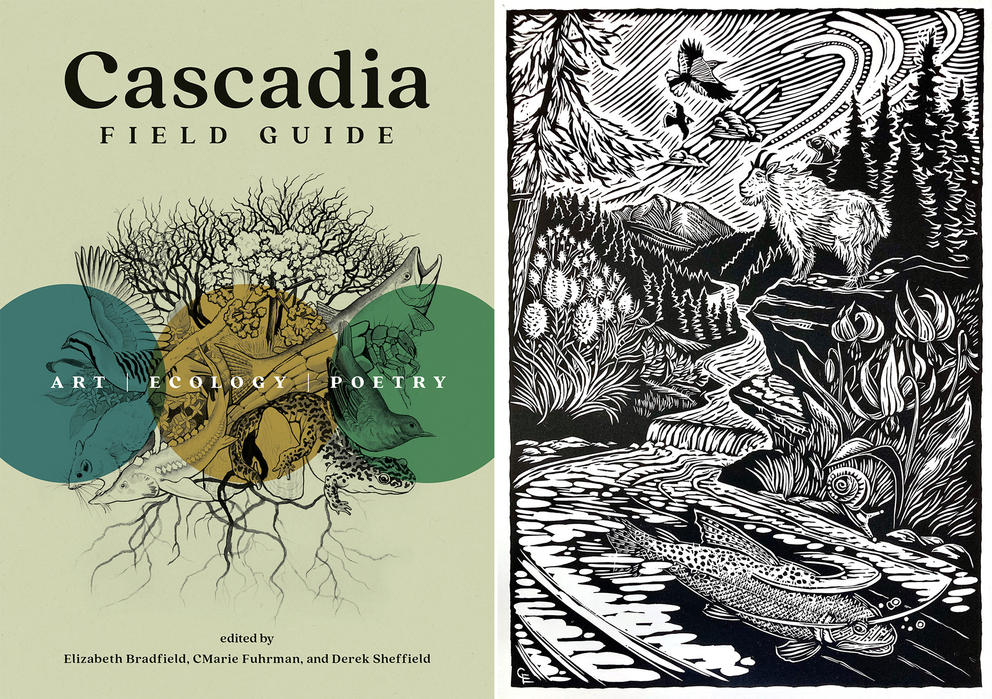Even if you graduated long ago, you can always go back to school with the arts. Brain scientists say new arts experiences create new neural pathways, so consider your artful wanderings a productive education. You can start with a couple shows landing this month (both opening for First Thursday in Pioneer Square tonight).
ArtSEA: Notes on Northwest Culture is Crosscut’s weekly arts & culture newsletter.
Greg Kucera Gallery has a new exhibit of Prints and Works on Paper (Sept. 7 - 30) by American painting legend (and revered University of Washington art professor) Jacob Lawrence. The show serves as an education in his powerful use of color blocking and simple lines, not to mention the African American history he embeds in his work.
Look at his 1977 lithograph “Carpenters,” for example. See the massive arms on the closest figure? But wait, Lawrence hasn’t fully outlined the arms at all — he’s implied them with his visual powers of suggestion. And those wrists! A few tiny lines speak a whole anatomy, and an expression of deep thought, as seen on the man’s face.
Next door, at Foster/White Gallery, another renowned Northwest artist offers lessons in wildlife. Tony Angell, known for his exquisite sculptures and drawings of birds, is showing the images he contributed to the forthcoming book Bird Day: A Story of 24 Hours and 24 Avian Lives (Sept. 7 - 23; book signing with Angell on Sept. 16).
Written by ornithologist Mark E. Hauber, Bird Day traces the around-the-clock activities of our feathered friends in short vignettes, brought to life by Angell’s detailed illustrations. Witness the black-crowned night heron stepping slowly through the reeds, the Cook’s petrel slinking toward a dark nest. See how Angell captures claws, beaks and body language — and think about how you might draw your own backyard birds.
If you’re looking to fill your backpack with nature books this fall, you’ll want to include Cascadia Field Guide: Art, Ecology, Poetry. Released this past spring by local Mountaineers Books, it’s a lovely anthology of natural history.
Each short chapter about Northwest flora and fauna — chum salmon, yellow skunk cabbage, hoary marmots, lodgepole pines and 124 others — is accompanied by a poem by a regional writer and an illustration by a local artist.
The pairing of factual information with artistic interpretation lights up all corners of the noggin, and that’s intended.
As editors Elizabeth Bradfield, CMarie Fuhrman and Derek Sheffield note in the introduction, the hope is to expand STEM into STEAM (adding art to the recent educational emphasis on science, technology, engineering and mathematics) and thereby “engage the heart” and “connect more fully with the non-human world.”
I’ve kept a copy on my nightstand all summer, taking little sips of it before I turn out the lights. A few of many favorite lines:
“A salmonberry is a / luminous spiral, / a golden basket, / woven of sunshine, / water, and birdsong” (Rena Priest); “Fur fat and stock-still in the trail / they appear to be looking / into a mythic sky, posed / for a feral portrait” (Derek Sheffield on marmots); “you’re the flavor / of my best, / most necessary / kiss” (Kathleen Flenniken on thimbleberry); “When I slip, just slightly, in the dark, / I know it isn’t a wet leaf, / But you, loose toe from the old life” (Theodore Roethke on slugs).
You can hear more poetic takes on our bioregion when Cascadia Field Guide editors and contributors (including Rebecca Hoogs, Lena Khalaf Tuffaha, Rachel Edelman, Elizabeth Austen and Christianne Balk) read from the compendium at Elliott Bay Books (Sept. 29, 7 p.m.).
Of course there’s a more literal way to go back to school this fall: take an extracurricular arts class. There are so many options!
In July, Cornish College of the Arts announced its new Cornish+ program, featuring dozens of studio-based, a la carte adult classes (and some for kids too). You can learn abstract painting or accordion bookmaking, “acting for workplace communication” or unarmed theatrical combat (the latter is perhaps also useful in the workplace). There’s beginning Taiko drumming, piano 101 and hip hop fundamentals with local performer Majinn.
Based in Georgetown and billing itself as “an art school for people like you,” the Seattle Artist League offers all kinds of visual arts classes (in-person and online) for hobbyists and people hoping to go pro. There are beginner classes in oil painting, Sumi, figure drawing and pottery (this last tends to fill up). Plus figure sculpting, contemporary painting and “drawing for busy people.”
Other local seats of visual arts learning include old standbys like Gage Academy of Art (since 1989) and Pratt Fine Arts Center (since 1976). Hugo House (since 1994) offers a whole slew of writing classes, including fiction, memoir, poetry and “breaking through writer’s block.” And at Freehold Theatre Lab (since 1991) you can learn acting, playwriting, auditioning, improv and many other theater skills — but note: At this writing only two spots were left in the clown class.
Or perhaps try a classic method of tapping into your inner artist: The Artist’s Way. Based on the massively influential 1992 self-help book by Julia Cameron, the Seattle Artist’s Way Center (founded by former Freehold teacher Kate Gavigan in 2009) leads small online classes through the techniques in the book, including those dreaded — but revealing — “morning pages,” three pages of stream-of-consciousness writing by hand, every morning.
Which is a good reminder: better pick up some cool school supplies before you dive in.
Get the latest in local arts and culture
This weekly newsletter brings arts news and cultural events straight to your inbox.





